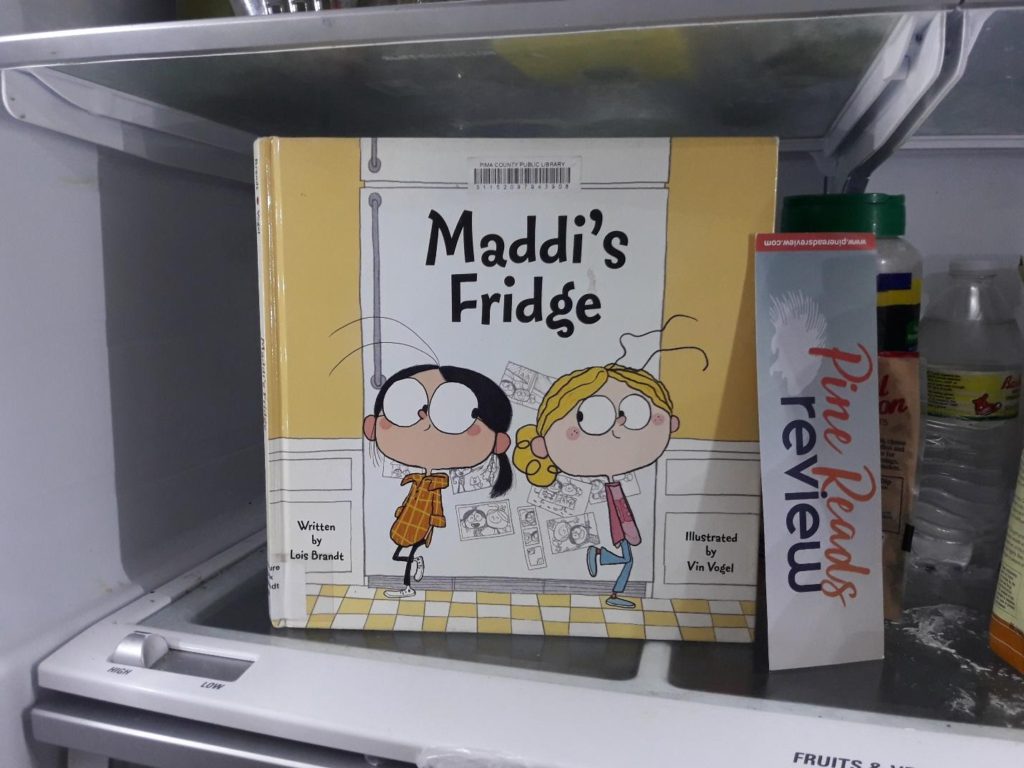
When I first read Maddi’s Fridge by Lois Brandt, I was struck by how great of a job it did both telling a story and delivering a message. At that first reading, I also teared up at how sweet the ending was—as did one of my coworkers, who was also introduced to the book. This isn’t your average story about an “issue” or problem that kids face; it is first and foremost a story about friendship and community. It just so happens to simultaneously teach readers about childhood hunger, an issue that is pervasive in our communities (according to Brandt it affects one in every five US children), but is not as talked about as it should be.
The story opens on Maddi and Sofia, two friends who enjoy playing at the city park. But after playtime, when Sofia runs upstairs to Maddi’s apartment for a snack, she discovers that Maddi has no food in her fridge. Maddi begs her friend not to tell anyone that her family does not have money to afford groceries, and Sofia leaves to her own home, where her fridge is stocked with “milk and eggs and tortillas and cheese and lettuce and jam and salsa and tofu and even half a can of dog food” and her mother has a hot dinner waiting.
Sofia endeavors to help Maddi, secretly at first, by bringing her friend snacks that mom says are healthy, like fish and eggs. However, most of her ideas are “not good for backpacks,” and Sofia continues to think about all the food she has in her own home, while her friend must go hungry. Sofia is forced to decide if she will keep Maddi’s secret or if she will ask for help to give her friend food to fill her refrigerator.
Brandt successfully depicts Sofia’s process learning about childhood hunger and coming to terms with her own ability to have a fully stocked fridge while her friend cannot. Sofia is a great model for kids, because she will do anything she can to help her friend. At the same time, Maddi helps Sofia by being an encouraging friend and aiding her with scaling the climbing wall in the park, which Sofia is unable to do. This choice shows that Maddi is still a regular kid, not defined by her socioeconomic status or inability to buy groceries; she is not a powerless character and she may motivate readers who are also in a similar position.
With the aid of Vin Vogel’s warm and friendly illustrations, Brandt discusses the issue of food insecurity by investing readers in a friend with an empty fridge. Sofia’s process learning about childhood hunger is authentic and genuine, as many children who know where their next meal is coming from do not understand what it means to go hungry, until it affects someone they care about. The story hits home with the details it includes, such as mentioning that Sofia even has “half a can of dog food” in her fridge, while Maddi has nothing, and illustrating Sofia’s uncertainty in whether or not to tell her friend’s secret.
Brandt gives readers the chance to learn more about the topic by including information in the back of the book about resources and advice for friends with empty refrigerators. This book demonstrates how food insecurity is a community issue and can be solved by compassion, caring and sharing. Readers can connect to Sofia and Maddi’s story. Maddi’s Fridge teaches us how to successfully talk about social issues with children, and how impactful each of us can be in the lives of those we care about when we choose to step up and help out.
PRR Writer, Mandy Becker